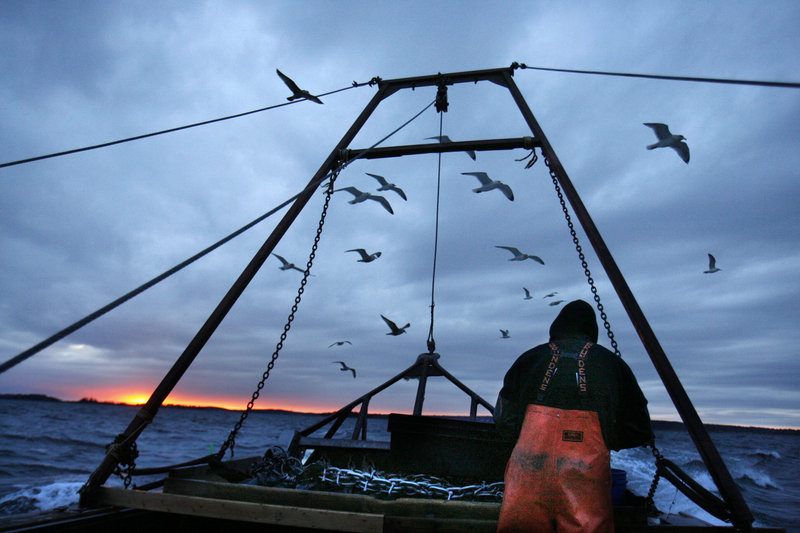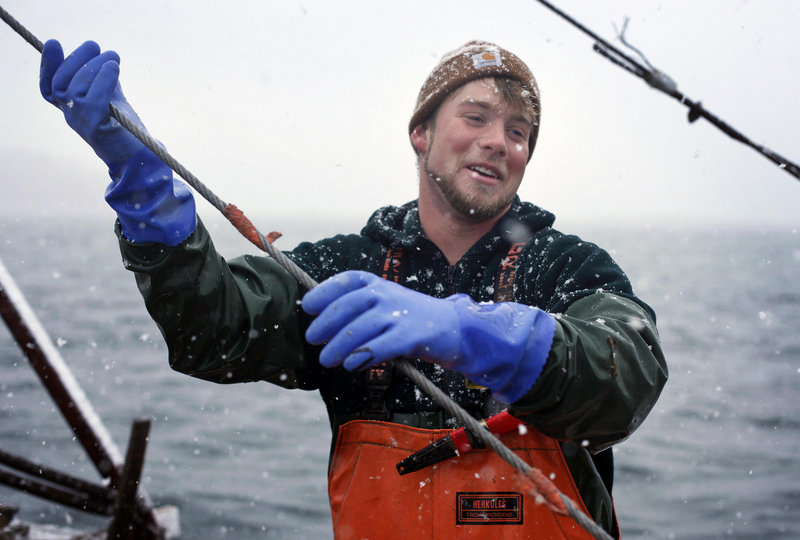Maine scallop fishermen expect to get record prices for their catch this season, with strong global demand and a diminished supply from Japan and other scallop-producing nations.
The weak U.S. dollar also is helping to boost prices, said Dana Temple, who owns Crescent Bay Inc., a seafood company in Cape Elizabeth.
“The prices these guys are going to get are probably going to be higher than they’ve ever gotten in the history of this fishery,” said Temple, who has been selling scallops for 35 years. The higher price for fishermen means that consumers will pay more in restaurants and food stores.
Sea scallops, which are similar to but bigger than bay scallops, have been harvested along the Maine coast since the late 1800s. At times, scallops have been the state’s second-most valuable seafood, behind lobster.
Maine scallops are considered high quality because they’re brought to shore the same day that boats drag them off the ocean floor or divers harvest them by hand. The large boats that drag for scallops on Georges Bank off southern New England can spend five days or more at sea before they bring their catch to port. The scallops are shucked at sea, with the shells thrown back into the ocean.
Maine’s fishery has had its ups and downs, with fishing increasing sharply when scallops are plentiful. In the 1980s and ’90s, Maine fishermen routinely harvested well over a million pounds of scallop meat in state waters, with the catch valued at $5 million to $10 million a year. The harvest peaked at 3.8 million pounds, worth $15 million, in 1983.
In recent years, the catch has fallen off sharply, which regulators blame on overfishing. Fishermen caught 195,000 pounds, valued at $1.6 million, in Maine waters last year, according to the Department of Marine Resources. That was just a small fraction of the entire U.S. catch, which totaled 58 million pounds, valued at $455 million.
Still, scallops provide income in the winter for fishermen who go after lobsters, groundfish and sea urchins at other times.
Maine instituted measures two years ago to help restore scallop populations and address overfishing. It shut down 20 percent of the coastline to scallop fishing, froze the number of licenses, shortened the season, increased the legal size limit and limited the daily catch. The areas that were closed to fishing are scheduled to open after the current season ends.
There are signs that the conservation efforts have started to pay off. In Cobscook Bay, Down East, the mass of scallops had increased fivefold in one area just a year after it was closed to fishing. Fall surveys show promise in some, but not all, of the other closed areas.
“I think it’s coming back,” said James Ackley, a fisherman in Machias. “But it took 12 to 15 years to get where it was, so it won’t get back overnight.”
The Maine scallop season began Dec. 17 and runs through March. Its opening day drew many boats, especially to Cobscook Bay. There, fishermen reported smaller and fewer scallops than expected, prompting the Department of Marine Resources to call a meeting with fishermen this week to get a handle on what’s happening.
The scallop population is highly variable from place to place, and fishermen won’t know for certain how successful the conservation efforts have been until closed areas are reopened next year, said Robin Alden, director of the Penobscot East Resource Center, a Stonington-based nonprofit that works on fishery issues in eastern Maine.
“We don’t know yet if the scallop-closed areas are going to replenish,” she said. “It’ll probably be yes in some places and no in others. It depends on whether you chose the right areas in the first place, and then what Mother Nature does with it.”
For the scallops that fishermen do bring in, the price will likely be high. Ackley and others expect perhaps $10 a pound or even more.
The U.S. scallop market has been strong in recent years, with the per-pound price that fishermen received rising 28 percent from 2009 to 2010, to $7.92 a pound.
With Japanese scallop exports way down since March’s tsunami and nuclear disaster, supplies remain tight and prices will likely stay high, said Temple, at Crescent Bay Inc. Although there’s little, if any, health threat from Japanese scallops, buyers don’t want to pay high prices for scallops that the public is wary of eating, he said.
“Japan used to send hundreds of loads of product over here, and it’s tough to sell it now,” Temple said.
The higher prices and rebounding scallop populations are good news for Maine fishermen, Ackley said. But he’s concerned that those factors could spur more fishing, which would send stocks plummeting again.
Maine sells 800 scallop fishing licenses a year, but last year only 234 fishermen actually caught scallops. If the population and price are good enough, more fishermen could head out this year.
“I think the effort will be more this year than it’s been for four or five years,” Ackley said. “And I believe next year there will be even more effort.”
Copy the Story Link
Send questions/comments to the editors.







Success. Please wait for the page to reload. If the page does not reload within 5 seconds, please refresh the page.
Enter your email and password to access comments.
Hi, to comment on stories you must . This profile is in addition to your subscription and website login.
Already have a commenting profile? .
Invalid username/password.
Please check your email to confirm and complete your registration.
Only subscribers are eligible to post comments. Please subscribe or login first for digital access. Here’s why.
Use the form below to reset your password. When you've submitted your account email, we will send an email with a reset code.